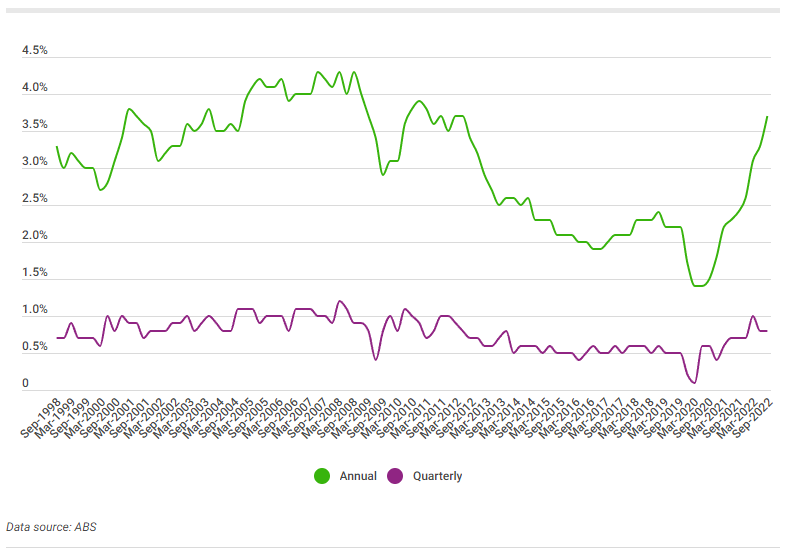In the public sector, base pay packets recorded the highest quarterly (0.9%) and annual (3%) wage growth for the sector in a decade.
- ABS Wage Price Index (WPI) revealed wages grew 0.8% in the March quarter, 3.7% annually.
- Public sector base pay packets recorded the highest quarterly and annual growth in a decade.
- NAB and CBA economists noted a quarterly increase of over 0.9% could see the RBA hike rates in June - there may be a cause for a pause given the softer than expected result.
Meanwhile, in the private sector, base pay packets rose 0.8% over the March quarter.
ABS Acting Head of Price Statistics Leigh Merrington said annual wages growth of 3.7% is the highest since the 2012 September quarter.
“Low unemployment, a tight labour market, and high inflation are all reflected in the data,” Ms Merrington said.
“Wage outcomes over the March quarter 2023 saw a continued lift in the share of jobs receiving wage rises of between 4-6%, which is the highest share since 2009.
“The share of jobs with a wage rise of 2% or less has fallen from over 50% in mid-2021 to less than 20%.”

Westpac economists hit the nail on the head in terms of quarterly growth, correctly predicting a 0.8% increase.
CommBank, ANZ, and NAB had all projected a 0.9% quarterly uplift.
Prior to Wednesday’s release, NAB Economist Tapas Strickland said the wage price index would contain some clues as to whether the RBA would hike rates once more in June.
“Key according to these Minutes is whether there is evidence that productivity will pick up to ensure the wages growth forecasts contained in the May SoMP [statement of monetary policy] are consistent with the RBA’s forecasts,” Mr Strickland said.
“An earlier hike in June cannot be ruled out if the first-quarter wage price index were to print above the RBA’s expectations of around 0.9% - NAB has also pencilled in 0.9%.”
CommBank Head of Australian Economics Gareth Aird echoed a similar sentiment.
“An increase of more than 1.0% would raise the risk that the RBA increases the cash rate again in June, particularly if the April labour force survey prints stronger than expected,” Mr Aird said.
With the quarterly result softer than expected, there is the possibility the RBA may hold off hiking the cash rate until after next month to assess other key data sets - GDP, and monthly and quarterly inflation.
NAB has pencilled in at least one more rate rise with a further increase to 4.35% not out of the equation.
Productivity levels to be carefully watched
While the RBA minutes revealed the possibility of pausing the cash rate in May, concern about weak productivity growth tipped the board in favour of an increase in a “finely balanced” decision.
“Various factors might explain the weak productivity outcomes, including COVID-19 related disruptions and strong growth in employment in government-funded services, where achieving productivity increases is often difficult,” the minutes read.
“Members observed that the forecast for inflation to return to the top of the target band by mid-2025 was predicated on productivity growth returning to around the modest pace recorded prior to the pandemic.
“If this did not occur, growth in unit labour costs would be uncomfortably fast.”
The higher the productivity, the faster the economy can expand without increasing inflation. Without an increase in productivity growth, nominal wage rises of 3.5-4% would be inconsistent with the inflation target.
The RBA does not expect inflation to reach the expected target underlying band of 2-3% until mid-2025.
"On the climb: quarterly wages increase by 0.8% once again" was originally published on Savings.com.au and was republished with permission.
